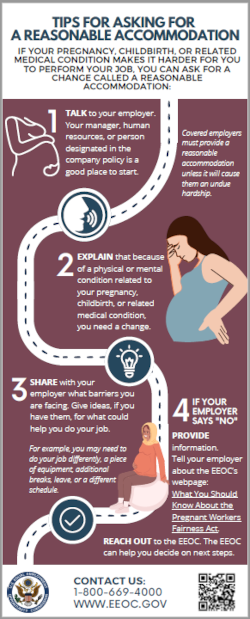Supporting Pregnant Workers: Examples of Reasonable Accommodations for a Happier, Healthier Workplace

Hey there, folks. If you’re a boss or HR manager, you know how important it is to create a supportive work environment for all employees, including those who are expecting. Pregnancy is a major life event that can bring a bunch of physical and emotional changes, and sometimes, women need a little extra help to keep on working safely and comfortably.
That’s where reasonable accommodations come in – we’re talking changes to the workspace or job duties that help pregnant workers do their thing without putting themselves or their unborn baby at risk. In this article, we’ll go over some examples of reasonable accommodations for pregnant workers, what you need to know about providing them, and how they can benefit everyone in the workplace.
What are Reasonable Accommodations, Anyway?
So, what exactly are reasonable accommodations? They’re changes or modifications that you make to the workspace or job duties to help someone with a disability – and pregnancy is considered a temporary disability – perform their job safely and effectively.
Reasonable accommodations can be simple, like providing a stool for a pregnant worker to sit on, or more complex, like restructuring job duties to reduce heavy lifting. The goal is to make sure that pregnant workers can keep on working without worrying about their health or the health of their unborn baby.
The Law is on Your Side (and the Pregnant Worker’s Side)
You might be wondering what laws require you to provide reasonable accommodations for pregnant workers. In the US, it’s basically a combo of federal, state, and local laws that require you to provide reasonable accommodations for pregnant workers.
The Pregnancy Discrimination Act (PDA) is a federal law that prohibits employers from discriminating against pregnant workers. The Americans with Disabilities Act (ADA) is another law that requires employers to provide reasonable accommodations for workers with disabilities, including pregnancy.
Examples of Reasonable Accommodations for Pregnant Workers
So, what are some examples of reasonable accommodations for pregnant workers? Here are a few:
Temporary Modifications to Job Duties
- Light Duty: Provide light duty or modified duties that reduce heavy lifting, bending, or standing. For example, if a pregnant worker’s job requires her to lift heavy boxes, you could temporarily reassign her to a desk job or provide her with a lifting device.
- Job Restructuring: Restructure job duties to eliminate tasks that are hazardous or difficult for pregnant workers. For example, if a pregnant worker’s job requires her to work with hazardous chemicals, you could temporarily reassign her to a job that doesn’t involve chemicals.
Workplace Modifications
- Ergonomic Changes: Make ergonomic changes to the workspace to reduce discomfort or injury. For example, you could provide a stool or adjustable chair to help a pregnant worker sit comfortably.
- Accessible Break Rooms: Provide accessible break rooms or rest areas where pregnant workers can take breaks and rest. For example, you could provide a quiet room with a comfortable couch or chair.
Leave and Time Off
- Pregnancy-Related Leave: Provide pregnancy-related leave or time off for doctor’s appointments or prenatal care. For example, you could allow a pregnant worker to take a few hours off each month for prenatal care.
- Flexible Scheduling: Offer flexible scheduling to help pregnant workers balance work and family responsibilities. For example, you could allow a pregnant worker to start her day earlier or later to avoid rush hour traffic.
Other Accommodations
- Lactation Support: Provide lactation support or a designated lactation room for breastfeeding workers. For example, you could provide a private room with a comfortable chair and a mini-fridge for storing breastmilk.
- Parking and Transportation: Provide parking or transportation accommodations for pregnant workers. For example, you could provide a designated parking spot close to the entrance or offer transportation reimbursement to and from work.
How to Provide Reasonable Accommodations
Providing reasonable accommodations for pregnant workers is easier than you think. Here are some steps you can follow:
- Ask the Pregnant Worker: Ask the pregnant worker what she needs to perform her job safely and comfortably. This can be a conversation or a written request.
- Assess the Workplace: Assess the workplace to identify potential hazards or barriers for pregnant workers. This can include a walk-through of the workspace or a review of job duties.
- Provide Options: Provide options for reasonable accommodations that meet the pregnant worker’s needs. This can include temporary modifications to job duties or workplace modifications.
- Document the Accommodation: Document the accommodation and any changes to job duties or the workspace. This can include a written agreement or a memo to HR.
Benefits of Providing Reasonable Accommodations
Providing reasonable accommodations for pregnant workers can benefit everyone in the workplace. Here are a few benefits:
- Increased Productivity: Reasonable accommodations can help pregnant workers stay on the job and perform their duties safely and effectively.
- Reduced Turnover: Providing reasonable accommodations can reduce turnover and retain valuable employees.
- Improved Morale: Reasonable accommodations can improve morale and create a more positive work environment.
Examples of Reasonable Accommodations for Pregnant Workers: Closing Thoughts
Providing examples of reasonable accommodations for pregnant workers is just one way to create a supportive work environment for all employees. By understanding the laws that require reasonable accommodations and providing options that meet pregnant workers’ needs, you can help create a happier, healthier workplace for everyone.